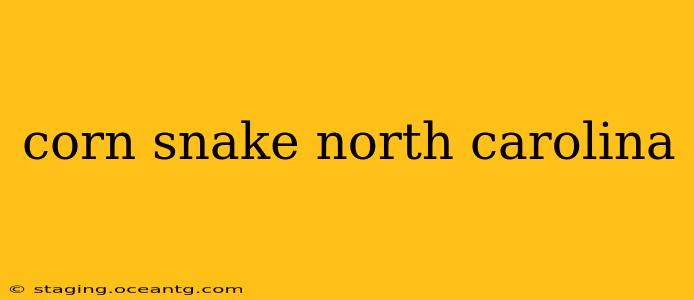North Carolina's diverse ecosystem provides a suitable habitat for various reptile species, including the popular corn snake. These docile and beautiful snakes are a frequent sight in the state, making them a subject of interest for both herpetologists and pet enthusiasts. This comprehensive guide explores everything you need to know about corn snakes in North Carolina, addressing common questions and concerns.
Where are Corn Snakes Found in North Carolina?
Corn snakes ( Pantherophis guttatus) are found throughout much of North Carolina, inhabiting a wide range of habitats. You're most likely to encounter them in the eastern and central parts of the state, where they thrive in areas with ample cover and prey. These areas often include fields, forests, and even suburban areas with suitable hiding places. They are particularly fond of rocky areas and old stone walls, providing excellent shelter. While not exclusively found in these locations, their presence is heavily correlated with these environmental factors.
Are Corn Snakes Dangerous?
Are Corn Snakes Venomous? No, corn snakes are not venomous. They are completely harmless to humans, posing no threat beyond a mild fright if unexpectedly encountered. Their temperament is generally docile and calm, making them popular as pets.
What Do Corn Snakes Eat in North Carolina?
Corn snakes are primarily ambush predators. Their diet in North Carolina primarily consists of rodents, such as mice and rats, and occasionally other small mammals. Their hunting strategies rely on patiently waiting for unsuspecting prey before striking quickly and constricting to subdue them. Their natural environment provides an abundance of such prey, contributing to their successful population within the state.
How to Identify a Corn Snake in North Carolina?
Identifying a corn snake requires understanding its key characteristics. They are typically reddish-brown or tan, with darker saddle-shaped markings along their backs. These markings are often outlined with black borders. The belly is usually cream-colored or yellowish. However, color morphs exist, resulting in variation in coloration and pattern. Size can vary, with adults reaching lengths of 3-5 feet.
What is the Conservation Status of Corn Snakes in North Carolina?
While not currently considered threatened or endangered in North Carolina, it's crucial to remember responsible interactions with wildlife. Avoid handling wild corn snakes unless you're a trained professional, and always respect their habitat. Their populations are generally healthy, though like all wildlife, habitat loss and fragmentation pose ongoing threats.
Can I Keep a Corn Snake as a Pet in North Carolina?
Keeping corn snakes as pets is legal in North Carolina. However, responsible pet ownership requires research and commitment. Ensuring proper enclosure, diet, and care is crucial for their well-being. Many breeders in North Carolina offer captive-bred corn snakes, helping to support conservation efforts while providing a readily available supply for those interested in keeping them as pets.
What Should I Do If I See a Corn Snake in North Carolina?
If you encounter a corn snake in North Carolina, the best course of action is to leave it alone. Admire it from a safe distance, appreciating its beauty and role in the ecosystem. Corn snakes are beneficial to humans, helping control rodent populations. Only intervene if the snake appears injured or is in immediate danger. Contact your local wildlife agency or a qualified reptile handler if you need assistance.
This guide provides a comprehensive overview of corn snakes in North Carolina, highlighting their distribution, behavior, and conservation status. Understanding and appreciating these fascinating creatures is key to ensuring their continued presence in the state's diverse ecosystem. Remember responsible interaction is crucial to both the snake's well-being and your own safety.
